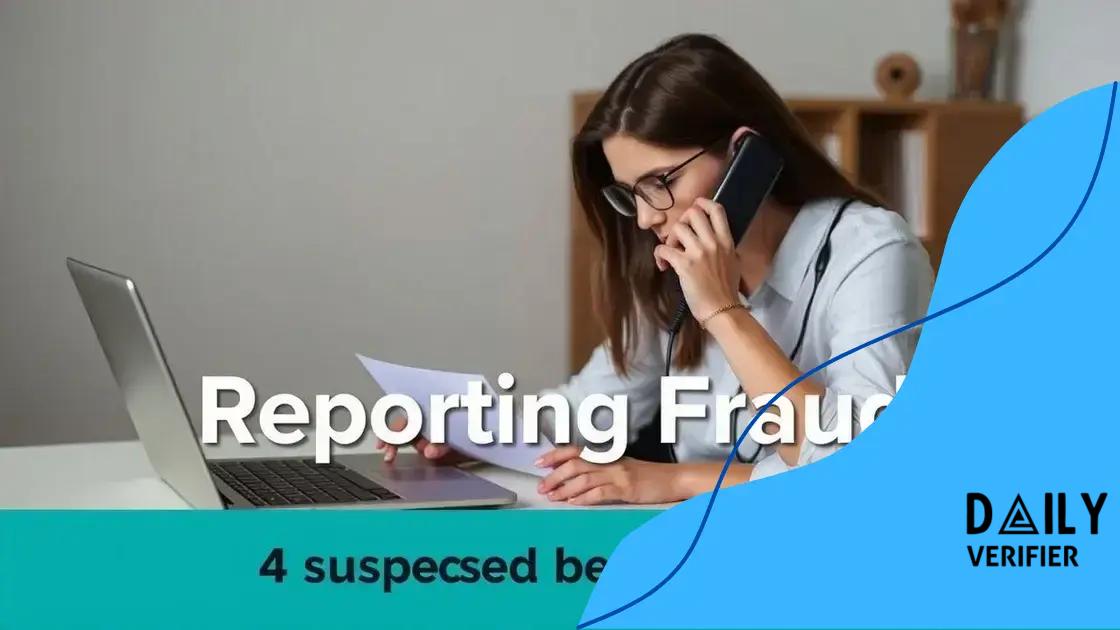Benefit fraud tips rise sharply in 2023

Benefit fraud refers to the act of providing false information to illegally obtain government benefits, and it can involve tactics such as misreporting income or creating fake identities.
Benefit fraud tips rise sharply as more individuals seek ways to exploit the system. Are you aware of the latest trends and signs of fraud? Let’s delve into this pressing issue and uncover practical steps you can take.
Understanding benefit fraud: what you need to know
Understanding benefit fraud is essential in today’s environment. With increasing cases of fraud, knowing what to look for can help you protect yourself.
Many people are unaware of how benefit fraud occurs. It often involves individuals providing false information to access payments they are not entitled to. This can include using fake identities or hiding income.
Common Signs of Benefit Fraud
Identifying benefit fraud can be tricky. However, some common signs can raise your suspicions:
- Inconsistent personal information or discrepancies in applications.
- Sudden changes in lifestyle that don’t match reported income.
- Reports of individuals not residing at their declared address.
These indicators can provide clues when assessing potential fraud. Remember, being vigilant helps protect not only you but also the community.
Effects of Benefit Fraud
Benefit fraud has far-reaching consequences. It not only affects public funds but also the genuine recipients of benefits. When fraud occurs, it can lead to stricter regulations and reduced benefits for those in need.
Moreover, fraud impacts the overall trust in government assistance programs. Individuals who rely on these programs may find themselves facing more scrutiny, making it harder to receive the help they truly require.
How to Stay Informed and Report Suspicion
Staying informed is key when it comes to benefit fraud. Regularly checking updates from local authorities and being aware of scams can help protect you. If you suspect fraud, reporting it to the authorities is crucial. Here are steps you can take:
- Collect as much information as possible.
- Contact local benefit offices or hotlines.
- Maintain anonymity if desired during reporting.
By being proactive, you contribute to a fair and equitable system for everyone.
Common types of benefit fraud and how they occur
Understanding the common types of benefit fraud can help individuals recognize and prevent fraudulent activities. These fraudulent actions typically involve manipulating the system to receive benefits unlawfully.
1. Misrepresentation of Income
One prevalent type of benefit fraud is misrepresenting one’s income. Some individuals may underreport their earnings or fail to disclose other sources of income to qualify for benefits. This tactic is often used to gain higher payments than deserved.
2. Fabricated Identity
Another method involves creating a fabricated identity. Fraudsters may invent a fake name or use someone else’s identity to apply for benefits. This can lead to issues for both the individual whose identity is used and the system itself.
3. False Claim of Dependency
False claims about dependents are also a significant concern. Some people might exaggerate the number of dependents they have or claim fictitious dependents to receive additional benefits. These actions undermine the integrity of support programs.
- Exaggerating family size or relationships.
- Claiming nonexistent children for benefits.
- Colluding with others to inflate dependency claims.
These examples illustrate just a few ways individuals exploit the system. Awareness of these tactics is essential for protecting the community from benefit fraud.
4. Housing Fraud
Housing fraud occurs when individuals provide inaccurate information about their living situation. This can involve lying about rental agreements or the number of occupants in a household. Such actions are meant to secure housing benefits unlawfully.
Awareness of these common types of benefit fraud is crucial not only for potential victims but for society as a whole. By understanding these tactics, individuals and communities can remain vigilant and help maintain the integrity of benefit systems.
How to report suspected benefit fraud effectively

Reporting suspected benefit fraud effectively is crucial in maintaining the integrity of social support systems. Knowing how to do it properly can help prevent further abuse of benefits.
The first step in reporting suspected fraud is to gather as much information as you can. This includes collecting any relevant documents, such as application forms, communication records, or any evidence that supports your suspicion.
1. Identify the Right Authority
It’s important to report the fraud to the right agency. Each country or region typically has a specific department that handles benefit fraud. You can usually find this information on the official government website. Knowing who to contact helps ensure your report is processed efficiently.
2. Complete the Required Forms
Many agencies provide specific forms for reporting fraud. Take a moment to fill out these forms accurately. Details you may need include:
- The name of the person you suspect is committing fraud.
- Specific details about the fraudulent behavior observed.
- Your contact information, if you are comfortable sharing it.
Submitting complete and detailed information can greatly assist in the investigation.
3. Maintain Anonymity if Desired
If you prefer to remain anonymous, many agencies allow for anonymous reporting. This can often be done via a hotline or an online form. While anonymity is important, sharing as much information as possible increases the chances of the report being taken seriously.
Being prepared and informed about how to report suspected benefit fraud can make the entire process easier. Taking these steps can help protect your community and ensure that resources reach those who truly need them.
Protecting yourself from benefit fraud schemes
Protecting yourself from benefit fraud schemes is essential in today’s society. Being aware of the tactics used by fraudsters can help you safeguard your personal information and financial resources.
One way to protect yourself is by regularly monitoring your financial statements. Keeping an eye on your bank account and credit card transactions can help you quickly spot any suspicious activity. Additionally, being cautious about sharing personal information is crucial. Always think twice before providing details over the phone or online.
Know the Red Flags
Understanding the common signs of benefit fraud can help you take action before becoming a victim. These red flags include:
- Unsolicited offers of financial help or benefits.
- Requests for personal information from unknown sources.
- Pressure to make quick decisions regarding financial matters.
By being alert, you can better protect yourself from falling for these schemes. It’s also essential to keep your documents secure. Physical copies of personal and financial information should be stored in a safe place, while digital files should be password-protected.
Report Suspicious Activity
If you suspect that you are being targeted by a benefit fraud scheme, acting quickly can minimize any potential damage. Reporting any incidents to the authorities can help them investigate further. It also raises awareness of scams that may affect others in your community.
Education is a powerful tool in preventing benefit fraud. Stay informed about the latest scams and strategies used by fraudsters. This knowledge not only protects you but also empowers others as you share what you learn.
The role of authorities in combating benefit fraud
The role of authorities in combating benefit fraud is vital for preserving the integrity of social support systems. These agencies work tirelessly to investigate, prevent, and prosecute fraudulent activities.
One major responsibility of authorities is to establish clear guidelines and policies. This includes outlining what constitutes benefit fraud and the consequences for those who attempt to exploit the system. Training personnel in recognizing signs of fraud is also crucial to ensure effective enforcement.
Investigating Fraud Cases
When reports of fraud arise, authorities conduct thorough investigations. This process often involves:
- Gathering evidence from various sources, including financial records.
- Interviewing individuals involved, whether they are the suspected fraudster or witnesses.
- Collaborating with other agencies to share information and resources.
These investigations help build a strong case against those committing fraud and can lead to criminal charges.
Public Awareness Campaigns
Another vital aspect of their role is to educate the public. Authorities often launch awareness campaigns that inform citizens about the risks and signs of benefit fraud. These initiatives encourage individuals to report suspicious activities. Raising awareness is essential for community involvement in the fight against fraud.
Additionally, authorities provide resources where individuals can learn more about protecting themselves from becoming victims of fraud. Understanding the potential tactics used by fraudsters empowers citizens to be vigilant.
Ultimately, the collaboration between authorities and the community is key. By working together, they can effectively combat benefit fraud and ensure that the resources meant for those in need reach the right hands.
FAQ – Frequently Asked Questions about Benefit Fraud
What is benefit fraud?
Benefit fraud involves providing false information to receive government benefits that one is not entitled to. This can include misreporting income or creating fake identities.
How can I report suspected benefit fraud?
You can report suspected benefit fraud to your local benefit office or through designated hotlines. Make sure to provide detailed information to assist in the investigation.
What are the signs of benefit fraud?
Common signs include inconsistent personal information, sudden lifestyle changes that do not match reported income, and claims of nonexistent dependents.
How can I protect myself from benefit fraud schemes?
Stay informed about the tactics used by fraudsters, secure your personal information, and report any suspicious activities to the authorities quickly.






